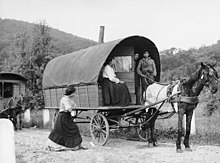The Sinti (also Sinta or Sinte; masc. sing. Sinto; fem. sing. Sintesa) are a subgroup of Romani people. They are found mostly in Germany, France and Italy and Central Europe, numbering some 200,000 people. They were traditionally itinerant, but today only a small percentage of Sinti remain unsettled. In earlier times, they frequently lived on the outskirts of communities.
| Total population | |
|---|---|
| ‹See Tfd› ≈ 200,000 | |
| Languages | |
| Sinte Romani | |
| Related ethnic groups | |
| Other Indo-Aryan peoples, especially Roma (Manouche) |

The Sinti of Central Europe are closely related to the group known as Manouche in France. They speak the Sinti-Manouche variety of Romani, which exhibits strong German influence.
Etymology and origin
The origin of the Sinti people, as with the broader Romani people, lies generally in the Indian subcontinent. While people from the western Indian subcontinent's Sindh region were mentioned in 1100 by Ahmad ibn Muhammad al-Maydani, it is unclear whether the Sindhi people were the ancestors of modern Sinti, though it is clear that Sinti and other Romani people originated in the northern Indian subcontinent.
The origin of the name is disputed. Scholar Jan Kochanowski, and many Sinti themselves, believed it derives from Sindhi, the name of a people of Sindh in medieval India (a region now in southeast Pakistan). Scholar Yaron Matras argued that Sinti is a later term in use by the Sinti from only the 18th century on, and is likely a European loanword. This view is shared by Romani linguist Ronald Lee who stated the name's origin probably lies in the German word Reisende meaning 'travellers'.
A recent study by Estonian and Indian researchers found genetic similarities between European Romani men and Indian men in their sample. Linguist N. B. G. Kazi stated that all Romani people are from Sindh.
History
The Sinti are a subgroup of Romani people mostly found in Germany. They arrived in Austria and Germany in the Late Middle Ages as part of the Romani emigration from the Indian Subcontinent, eventually splitting into two groups: Eftavagarja ("the Seven Caravans") and Estraxarja ("from Austria"). They arrived in Germany before 1540. The two groups expanded, the Eftavagarja into France and Portugal, where they are called "Manouches", and to Brazil, where they are called "Ciganos" (from Italian "zingaro"); and the Estraxarja into Italy and Central Europe, mainly what are now Croatia, Slovenia, Hungary, Romania, the Czech Republic and Slovakia, eventually adopting various regional names.
The Holocaust
The Sinti migrated to Germany in the early 15th century. Despite their long presence, they were still generally regarded as beggars and thieves, and, by 1899, the police kept a central register on Sinti, Roma, and Yenish peoples. Nazi Germany considered them racially inferior (see Nazism and race), and persecuted them throughout Germany during the Nazi period – the Nuremberg Laws of 1935 often being interpreted to apply to them as well as the Jews.
Adolf Eichmann recommended that Nazi Germany solve the "Gypsy Question" simultaneously with the Jewish Question, resulting in the deportation of the Sinti to clear room to build homes for ethnic Germans. Some were sent to the territory of Poland, or elsewhere (including some deported to the territory of Yugoslavia by the Hamburg Police in 1939) others were confined to designated areas, and many were eventually murdered in gas chambers. Many Sinti and Roma were taken to Auschwitz-Birkenau, where they were put in a special section, called the "gypsy camp". Josef Mengele often performed some of his infamous experiments on Sinti and Roma. On 2 August 1944, the "gypsy camp" was closed, and approximately 4,000 Sinti and Roma were gassed during the night of 2–3 August and burnt in the crematoria. The date 2 August is commemorated as Roma and Sinti Holocaust Remembrance Day.
In the concentration camps, the Sinti were forced to wear either a black triangle, indicating their classification as "asocial", or a brown triangle, specifically reserved for Sinti, Roma, and Yenish peoples.
Notable people
- Wawau Adler (born 1967) - jazz guitarist
- Jakob Bamberger (1913 - 1989) - boxer and activist
- Drafi Deutscher (1946 - 2006) - singer and songwriter
- Lily Franz (1924 - 2011) - writer and holocaust survivor
- Philomena Franz (1922-2022) - writer and holocaust survivor
- Elisabeth Guttenberger (1926 - 2024) - activist and holocaust survivor
- Hugo Höllenreiner (1933 - 2015) - holocaust survivor and public speaker
- Mario Mettbach (1952 - 2021/22) - politician
- Schnuckenack Reinhardt (1921 - 2006) - jazz musician
- Marianne Rosenberg (born 1955) - singer and daughter of Otto Rosenberg
- Otto Rosenberg (1927 - 2001) - writer, activist and holocaust survivor
- Sido (born 1980) - rapper
- Johann Trollmann (1907 - 1944) - boxer and victim of forced sterilisation
- Häns'che Weiss (1951-2016) - jazz musician
See also
Citations
General and cited references
- Saul, Nicholas; Tebbutt, Susan, eds. (2004). The role of the Romanies: images and counter-images of 'Gypsies'/Romanies in European cultures. Liverpool: Liverpool Univ. Press. ISBN 978-0-85323-679-5.
Further reading
- Walter Winter, Struan Robertson (translator). Winter Time: Memoirs of a German Who Survived Auschwitz. Hertfordshire Publications, (2004), ISBN 1-902806-38-7.
- Reviewed by Emma Brockes: "We had the same pain", The Guardian, November 29, 2004.
- Sinti and Roma: Gypsies in German-speaking Society and Literature
- Sinti and Roma: Legal Status and Perspectives for a European Minority
- Roma in Europe: The Politics of Collective Identity Formation
External links
- Non-Jewish Victims of Persecution in Nazi Germany on the Yad Vashem website
- Wege nach Ravensbrück (Ravensbrück concentration camp: Memories of surviving female Sinti) (in German)
- F. N. Finck, Lehrbuch des Dialekts der deutschen Zigeuner (1903) in the Internet Archive (in German)